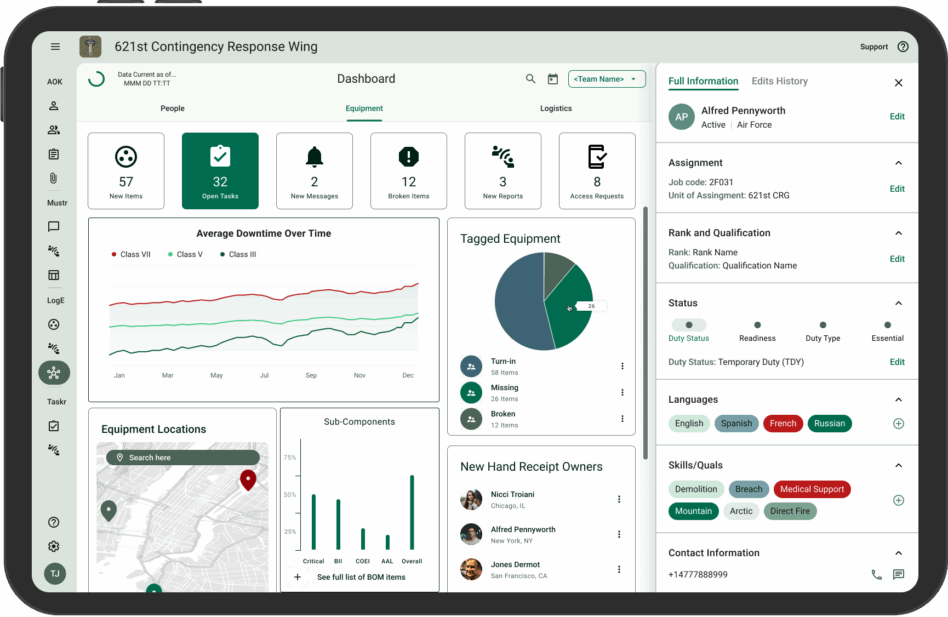Remember when we said that some of the most cutting-edge defense tech isn’t necessarily the flying, sexy stuff? Well, we’re back to prove our point.
This morning, military operations software company Adyton announced to Tectonic in an exclusive release that they’ve received $11M in funding led by Venrock, with participation from Khosla Ventures, Liquid 2 Ventures, Alumni Ventures, Initialized Capital, Kindred Ventures, and Leblon Capital.
They’ve also secured a $7M multi-year contract with US Naval Aviation to deploy their core tech—the Adyton Operations Kit (AOK)—to thousands of sailors on multiple aircraft carriers, including the USS Stennis.
Problem set: Adyton was founded by Special Forces veterans James Boyd (CEO) and JJ Wilson (President) in 2019, and the company set out to build software that fixes some of the military’s greatest problems.
- Boyd is ex-Palantir, where he led the SOCOM business, and Wilson is ex-BCG.
- The company received an AFWERX SBIR shortly after launch and closed a $10M Series A led by Khosla in 2022.
In stock: They released the AOK last year. Put simply, the software is a much more efficient, data-driven way for the military to keep track of its stuff. Despite all of the talk of cutting-edge defense tech and bringing innovation to the Pentagon, most materiel management still happens the old-fashioned way: with pen and paper.
Adyton instead loads the thousands of PDF documents and Excel spreadsheets tracking everything from machine guns, to ammo, to the forklifts needed to transport missiles, into their database, allowing the US military to see exactly what is where, in what condition, and being used by who.
- AOK runs primarily on mobile phones. Boyd told Tectonic that they’ve designed the software’s classification protocols so that it can run on both government and personally owned devices.
- The company’s tech takes the bazillions of materiel data points tracked manually by the military each day and spits out an easy-to-use database for tracking supplies all the way down to the unit level.
- End users—the soldiers and sailors on the ground—can directly interact with the database, logging when things are missing, damaged, or just in a different place.
- Users can also tag the equipment they don’t need anymore, or that is out of date, like fax machines.
Time suck: It might seem mind-blowing that the DoD doesn’t have software like this already, but here we are. Boyd says that when he was a staff sergeant, he saw up close and personal the toll the manual accounting system took.
“As a Special Forces soldier, I was responsible for about a million dollars worth of communications and equipment, and I probably spent a month every single year keeping track of my equipment,” he said.
Plus, the software can even automatically generate paperwork for equipment checks.
“Nobody’s going to say the paperwork generation is sexy, but what it does is save hundreds of hours for end users every month,” Boyd said.
Keeping track: Now, why is knowing where stuff is (and people are) important? Well beyond the obvious—it’s good to know where your missiles are if a conflict breaks out in the Indo-Pacific, for example—this kind of centralized data is critical to the digital transformation the DoD is trying to pull off.
Without accurate, accessible data, many of the AI-powered force management or logistics platforms we talk about all the time can’t work very effectively.
Morgan Hitzig, who led the round for Venrock, told Tectonic that she invested in Adyton because their tech “[fills] that very important gap that makes the AI-driven decision-making platforms that we’re investing billions of dollars into actually work because they’re capturing that core data.”
Critical mass: Boyd told Tectonic that the company has taken a bottom-up approach to growth—they’ve started by converting users at the unit level and are working up to the enterprise level. Currently, the AOK:
- Is used across 50+ Army units, in regions from the Middle East to the Pacific
- Has 6000+ users, and will gain thousands more with these aircraft carriers
- Is deployed in 36 of the Army’s 50 brigade combat teams
- Is tracking $5B+ of military equipment
Boyd says that they’ve seen particular interest from the Special Forces and the army logistics side of things, where there are absolute mountains of equipment to keep track of.
Going forward, Boyd says the company will continue to scale up the AOK and will look at different use cases for the software, like personnel, training, and skill tracking.

